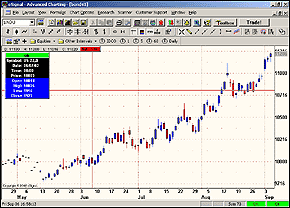REAL WORLD
The Time Is Right
Choosing The Right Time Frame
by Hal Masover
Using multiple time frames has many benefits, but which ones work for you?
A friend once described his perspective on time frames: "People have different definitions of 'long term,' 'short term,' and 'intermediate term.' For me, 'short term' is when I get on the phone with my broker and get in and out of a trade before I hang up. 'Intermediate term' is when I get into a trade, hang up, then call right back and get out. A long-term trade might be when I get into a trade, get off the phone, go to the bathroom, come back, call the broker, and get out."
On the other hand, some traders enter positions that can last for years. Clearly, there are very different definitions of "long term" and "short term."
Most likely your definitions fit somewhere between these extremes. But do you always maintain the same time frame definitions, or do you revise them with different trading methods? How do you find the right time frame for you? Is there a right time frame for you?
A man who charges for his trading courses once told me, "You can't trade off a 30-minute chart." But I have done just that, and I often trade off 45-minute charts and daily charts, too. Some traders trade off one-minute charts. I have discussed trading with others who use three-, seven-, 21-, 60-, and so on. Still others use weekly, monthly, and even quarterly charts. It just depends on what's right for you.
Here are some guidelines I have found for time frames that may be of use.

FIGURE 1: DECEMBER 2002 TREASURY BOND CONTRACTS. You can see the uptrend clearly when looking at the daily chart.
...Continued in the May 2003 issue of Technical Analysis of STOCKS & COMMODITIES
Excerpted from an article originally published in the May 2003 issue of Technical Analysis of STOCKS & COMMODITIES magazine. All rights reserved. © Copyright 2003, Technical Analysis, Inc.
Return to May 2003 Contents